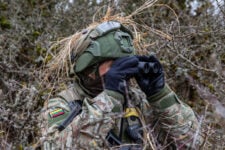A 1st Lt. with the Lithuanian KASP (National Volunteer Defence Forces) watches for enemy vehicles on a nearby road during Exercise Allied Spirit 2022 at the Joint Multinational Readiness Center (JMRC) in Hohenfels, Germany on Jan. 25, 2022.(US Army/Spc. Alisha Grezlik)
WASHINGTON — If lawmakers do not pass the stalled supplemental spending bill, the US Army will be forced to scale back NATO exercises in order to continue training Ukrainian soldiers, service secretary Christine Wormuth warned today, adding that the Army faces a similar challenge in the Middle East.
Lawmakers on Capitol Hill have yet to approve the Biden administration’s $105 billion supplemental spending request that includes military aid for Ukraine and Israel, and late last year the Pentagon ran out of funding to replace any weapons it sends to Kyiv. As part of that funding upheaval, Wormuth estimated that the service has now funneled approximately $500 million from other US Army Europe and Africa (USAREUR-AF) operation and maintenance accounts to make sure it can continue training Ukrainian forces in spots like Germany.
By the “late spring or summer, we would have to make some difficult choices about other exercises, for example, that we had planned to participate in,” she told reporters during a Defense Writers Group breakfast. “There’s a whole host of NATO exercises, for example, that our forces participate in.”
She didn’t specificity which activities the Army might need to drop out of, but the service regularly participates in exercises like Griffin Shock and the ongoing Allied Spirit. USAREUR-AF spokesman Col. Martin O’Donnell previously estimated that as of Jan 31, the international community had trained more than 118,000 Ukrainian troops at over 80 different training areas located around the world. From that total, 16,300 soldiers attended training at the US Army bases of Grafenwoehr and/or Hohenfels in Germany, with 9,900 completing combined arms training, 5,100 completing platform training, and 1,300 finishing staff and/or leadership training.
That stalled supplemental, though, isn’t just hitting the Army’s European plans: US Army Central (USARCENT) is in a similar spot trying to flow support to Israel and cover the cost of additional deployments to the region.
“The price tag for that, so far, isn’t as large but again, I think the [Army] Chief and I do worry,” Wormuth said. “Our budget has been flat for the last couple of years, we don’t have a lot of cash under the sofa cushions, and if we don’t get a budget, and we don’t get a supplemental, we’re going to probably have to cancel some things.”
The Army’s budget woes aren’t relegated to the supplemental holding pattern: the government is nearly five months into fiscal 2024 and operating under a continuing resolution that maintains spending at FY23 levels. It remains unclear if or when lawmakers will be able to push through the logjam and pass a spending bill, fund the entire year under a CR or shut the government down. (A vote on extending the CR is needed before midnight March 1 to avoid a partial shutdown while Department of Defense funding is set to lapse on March 8.)
If the Army is forced to operate under a CR the entire 12 months of the fiscal year, Wormuth warned that the service will not be able to proceed with several barracks projects and some modernization programs will take a hit. For example, the Army planned to deploy its new Mid-Range Capability (MRC) long-range launcher, also dubbed Typhon, in the Indo-Pacific this year as part of a $500 million investment in that capability. Operating under a CR will mean halting that investment, she added.
“Without a ‘24 appropriations, continuing under a CR…not having the supplemental for Ukraine hurts us,” Wormuth told reporters.
“Without the ability to do new starts, without the ability to do reprogramming things, we can’t invest in development of UAS and counter UAS systems, we can’t train with those systems, we can’t produce those systems as rapidly as we want to,” she later added.






![The sights from the 2024 Farnborough Airshow [PHOTOS]](https://centurionpartnersgroup.com/wp-content/uploads/2024/07/IMG_8722-scaled-e1721930652747-1024x577-hZjwVb-500x383.jpeg)




